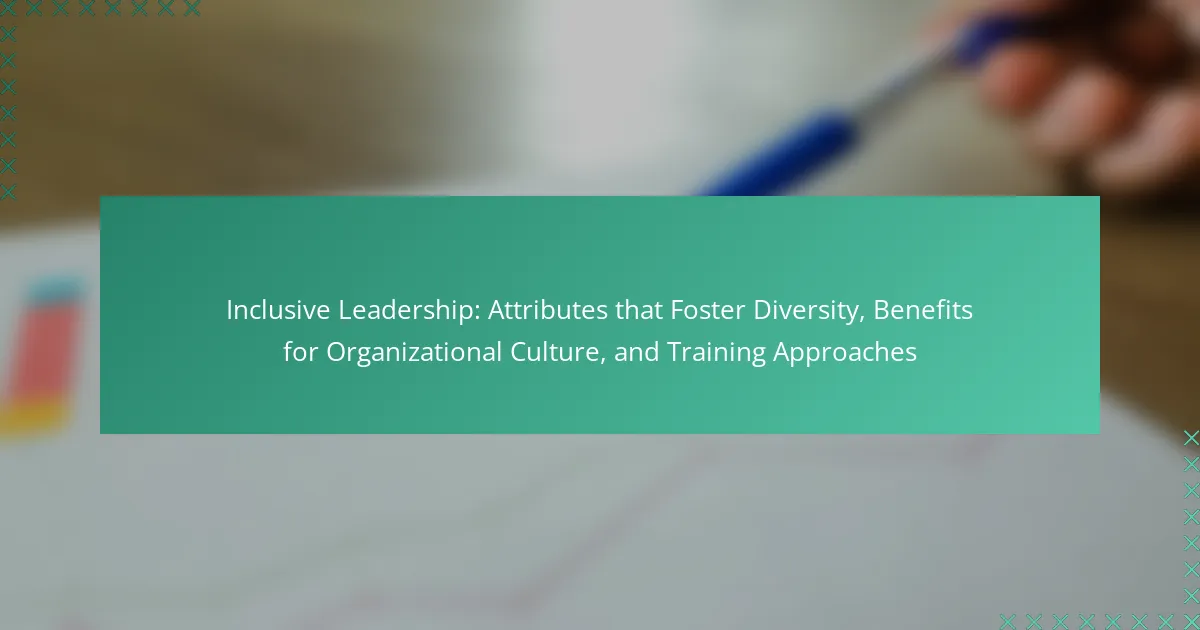Inclusive leadership is a leadership approach that emphasizes the importance of diversity and creating an inclusive environment within organizations. This style of leadership actively seeks to incorporate diverse perspectives, fostering collaboration and a sense of belonging among team members. Research highlights that inclusive leadership can significantly enhance team performance, innovation, and employee engagement, while also reducing turnover rates. Effective training methods for developing inclusive leadership skills include experiential learning, mentorship programs, and diversity training, all of which contribute to improved team dynamics and higher retention rates among diverse employees.

What is Inclusive Leadership?
Inclusive leadership is a leadership approach that values diversity and promotes an inclusive environment. It involves recognizing and leveraging the unique perspectives of all team members. Inclusive leaders actively seek input from diverse voices and create a sense of belonging. They foster collaboration and ensure that everyone feels heard and respected. Research shows that inclusive leadership can enhance team performance and innovation. A study published in the Harvard Business Review found that diverse teams are more creative and effective in problem-solving. This leadership style is essential for building a positive organizational culture.
How does Inclusive Leadership influence organizational dynamics?
Inclusive leadership significantly influences organizational dynamics by fostering a culture of collaboration and respect. It encourages diverse perspectives, leading to enhanced problem-solving and innovation. Research shows that inclusive teams are more engaged and productive. A study by Deloitte found that inclusive organizations are 1.7 times more likely to be innovation leaders in their market. Additionally, inclusive leadership reduces turnover rates by creating a sense of belonging among employees. This positive environment improves overall employee satisfaction and performance. Consequently, organizations with inclusive leaders tend to achieve better financial outcomes.
What are the key characteristics of Inclusive Leaders?
Inclusive leaders demonstrate key characteristics that foster a diverse and equitable environment. They exhibit empathy, allowing them to understand and relate to diverse perspectives. Effective communication is essential, as it facilitates open dialogue among team members. Inclusive leaders also prioritize collaboration, encouraging teamwork and collective problem-solving. They show cultural competence, recognizing and valuing differences among individuals. Additionally, they are committed to equity, ensuring fair treatment and opportunities for all. Research indicates that organizations led by inclusive leaders experience higher employee engagement and innovation. This data underscores the importance of inclusive leadership in fostering a positive organizational culture.
How does Inclusive Leadership differ from traditional leadership styles?
Inclusive leadership emphasizes diversity and collaboration, unlike traditional leadership styles that often prioritize hierarchy and authority. Inclusive leaders actively seek diverse perspectives and encourage participation from all team members. They create a culture of belonging, where every individual feels valued and heard. Traditional leaders may focus on decision-making power and directive control. Inclusive leadership fosters innovation by leveraging varied viewpoints, leading to better problem-solving. Research shows that inclusive teams are more engaged and productive, enhancing overall organizational performance. This approach aligns with modern workforce expectations for equity and inclusion.
Why is fostering diversity important in leadership?
Fostering diversity in leadership enhances decision-making and innovation. Diverse leaders bring varied perspectives and experiences. This variety leads to more creative solutions. Research shows that diverse teams outperform homogeneous ones. A McKinsey report found that companies in the top quartile for gender diversity are 21% more likely to experience above-average profitability. Additionally, diverse leadership reflects a broader customer base. This alignment can improve customer satisfaction and loyalty. Therefore, fostering diversity is crucial for effective leadership and organizational success.
What are the benefits of diversity in teams?
Diversity in teams enhances creativity and innovation. Diverse perspectives lead to a broader range of ideas. This variety improves problem-solving capabilities. Research shows that diverse teams outperform homogeneous teams in decision-making. A study by McKinsey found that companies in the top quartile for gender diversity are 21% more likely to outperform on profitability. Additionally, diverse teams increase employee satisfaction and retention. They foster an inclusive workplace culture. This culture attracts top talent from various backgrounds. Ultimately, diversity in teams drives better business outcomes.
How does diversity impact decision-making processes?
Diversity enhances decision-making processes by incorporating a variety of perspectives. This variety leads to more innovative solutions. Teams with diverse members often perform better in problem-solving tasks. Research shows that diverse teams can outperform homogeneous teams by up to 35% in decision-making effectiveness. Different backgrounds contribute unique insights that challenge groupthink. This results in more thorough evaluations of options. Diverse teams are also better at identifying potential risks. Ultimately, diversity fosters creativity and improves the quality of decisions made.

What are the benefits of Inclusive Leadership for Organizational Culture?
Inclusive leadership enhances organizational culture by fostering a sense of belonging among employees. It encourages diverse perspectives, leading to more innovative solutions. Organizations with inclusive leaders report higher employee engagement levels. A study by Deloitte found that inclusive teams outperform their peers by 80% in team-based assessments. Additionally, inclusive leadership reduces turnover rates, as employees feel valued and respected. Companies with inclusive cultures also attract top talent, as diversity is increasingly sought after by job seekers. Overall, inclusive leadership creates a positive work environment that drives performance and satisfaction.
How does Inclusive Leadership enhance employee engagement?
Inclusive leadership enhances employee engagement by creating an environment where all voices are valued. This leadership style fosters trust and collaboration among team members. Employees feel more connected when their unique perspectives are acknowledged. Research shows that inclusive teams are 1.7 times more likely to be innovative. This innovation leads to higher job satisfaction and commitment. Engagement increases when employees see their contributions making a difference. Moreover, inclusive leadership reduces turnover by promoting a sense of belonging. A study by Deloitte found that inclusive organizations have 2.3 times higher cash flow per employee. These factors collectively enhance overall employee engagement significantly.
What role does recognition play in fostering an inclusive environment?
Recognition plays a crucial role in fostering an inclusive environment. It validates individuals’ contributions and promotes a sense of belonging. When people feel recognized, they are more likely to engage and participate actively. Recognition helps to break down barriers between diverse groups. It encourages collaboration and mutual respect among team members. According to a study by the Society for Human Resource Management, 79% of employees who receive recognition report feeling more valued. This increased sense of value directly correlates with higher job satisfaction and retention rates. Therefore, effective recognition practices are essential for cultivating an inclusive workplace culture.
How does Inclusive Leadership contribute to employee retention?
Inclusive leadership contributes to employee retention by fostering a supportive and engaging work environment. This leadership style encourages diverse perspectives and promotes open communication. Employees feel valued and respected, which enhances job satisfaction. When individuals are included, their commitment to the organization increases. Research shows that inclusive workplaces see a 22% reduction in turnover rates. This is linked to higher employee morale and loyalty. Furthermore, inclusive leaders often provide opportunities for professional growth. Such development leads to increased employee engagement and retention.
In what ways does Inclusive Leadership drive innovation?
Inclusive leadership drives innovation by fostering diverse perspectives and encouraging collaboration. Diverse teams generate a wider range of ideas. This variety leads to more creative solutions. Inclusive leaders create a safe environment for sharing these ideas. Employees feel valued and empowered to contribute. Research shows that diverse teams outperform homogeneous ones in problem-solving. For instance, a study by McKinsey found that companies with diverse leadership are 33% more likely to outperform their peers. This evidence supports the link between inclusive leadership and enhanced innovation.
How does a diverse perspective lead to creative solutions?
A diverse perspective leads to creative solutions by integrating varied viewpoints and experiences. This diversity fosters innovative thinking and problem-solving. Different backgrounds contribute unique ideas and approaches. Such varied input challenges conventional thinking. Research shows that teams with diverse members outperform homogeneous teams in creativity. A study by McKinsey found that diverse companies are 35% more likely to outperform their peers. This advantage comes from the ability to see problems from multiple angles. Diverse teams can generate a wider range of solutions, enhancing overall creativity.
What are examples of innovative outcomes from inclusive teams?
Innovative outcomes from inclusive teams include increased creativity and improved problem-solving. Diverse perspectives lead to unique ideas and solutions. For instance, a study by McKinsey found that companies with greater diversity are 35% more likely to outperform their peers. Inclusive teams also enhance employee engagement and satisfaction. This results in higher retention rates and lower turnover costs. Additionally, inclusive teams often develop products that cater to a wider audience. This can lead to increased market share and revenue growth. Overall, inclusivity fosters an environment where innovation thrives.

What training approaches can develop Inclusive Leadership skills?
Training approaches that can develop Inclusive Leadership skills include experiential learning, mentorship programs, and diversity training. Experiential learning allows leaders to engage in real-world scenarios that enhance empathy and understanding. Mentorship programs pair emerging leaders with experienced mentors to foster guidance and support. Diversity training educates leaders on unconscious bias and cultural competence. Research shows that organizations implementing these approaches report improved team dynamics and employee satisfaction. For example, a study by the Harvard Business Review indicates that companies with inclusive leadership training have higher retention rates among diverse employees.
What types of training programs are effective for cultivating Inclusive Leaders?
Effective training programs for cultivating Inclusive Leaders include workshops on unconscious bias, diversity and inclusion seminars, and leadership coaching focused on empathy. Unconscious bias workshops help leaders recognize and mitigate their implicit biases. Diversity and inclusion seminars provide knowledge on the importance of diverse teams and inclusive practices. Leadership coaching enhances skills in empathy, communication, and conflict resolution. Research shows that organizations implementing such training programs see improved team performance and employee satisfaction. A study by McKinsey & Company found that companies with more diverse leadership teams are 33% more likely to outperform their peers.
How can organizations implement mentorship programs for inclusive practices?
Organizations can implement mentorship programs for inclusive practices by establishing clear objectives. These objectives should focus on promoting diversity and fostering an inclusive culture. Next, organizations need to identify potential mentors and mentees from diverse backgrounds. This ensures representation across various demographics.
Training sessions should be conducted for mentors to enhance their skills in inclusive practices. Organizations can also create structured matching processes based on shared interests and goals. Regular feedback mechanisms should be established to assess the program’s effectiveness.
Data from studies indicate that mentorship programs can increase retention rates among underrepresented groups by up to 30%. This highlights the importance of mentorship in creating an inclusive workplace.
What role do workshops play in promoting inclusive leadership skills?
Workshops play a crucial role in promoting inclusive leadership skills. They provide structured environments for participants to learn about diversity and inclusion. Workshops facilitate discussions that raise awareness of biases and barriers. They encourage collaboration and the sharing of diverse perspectives. Participants practice inclusive behaviors through role-playing and group activities. Research shows that organizations implementing such workshops see improved team dynamics. For example, a study by Catalyst found that inclusive leadership training increases employee engagement by 25%. This evidence supports the effectiveness of workshops in fostering inclusive leadership skills.
How can organizations measure the success of Inclusive Leadership training?
Organizations can measure the success of Inclusive Leadership training through various quantitative and qualitative metrics. Surveys can assess participants’ perceptions of inclusivity before and after training. Employee engagement scores can indicate changes in workplace culture. Retention rates of diverse talent can reflect the effectiveness of inclusive practices. Performance reviews may show improvements in team dynamics and collaboration. Additionally, feedback from focus groups can provide insights into behavioral changes among leaders. Data from these metrics can validate the impact of training on organizational culture.
What metrics can be used to assess the impact on organizational culture?
Metrics to assess the impact on organizational culture include employee engagement surveys, turnover rates, and productivity metrics. Employee engagement surveys measure staff satisfaction and alignment with organizational values. High engagement scores often correlate with a positive culture. Turnover rates indicate how well the organization retains talent. Lower turnover can signal a healthy culture. Productivity metrics assess output and efficiency, reflecting employee morale and commitment. Additionally, diversity and inclusion metrics evaluate representation and inclusiveness in the workplace. These metrics provide insights into cultural strengths and areas for improvement.
How can feedback from employees inform the effectiveness of training?
Feedback from employees can significantly inform the effectiveness of training. It provides insights into the relevance of training content. Employees can highlight areas where training meets their needs or falls short. This feedback helps identify gaps in knowledge and skills. Additionally, employee feedback can reveal the training’s impact on performance. It allows organizations to adjust training methods and materials accordingly. Research shows that organizations with effective feedback mechanisms see a 14% increase in employee engagement. Engaged employees are more likely to apply what they learn in training. Thus, employee feedback is crucial for refining training programs and enhancing overall effectiveness.
What best practices can enhance Inclusive Leadership in the workplace?
Best practices that enhance inclusive leadership in the workplace include fostering open communication, promoting diverse perspectives, and providing equitable opportunities. Open communication allows team members to express their ideas and concerns freely. This practice builds trust and encourages collaboration. Promoting diverse perspectives leads to better decision-making and innovation. Research shows that diverse teams outperform homogeneous ones by 35% in terms of performance. Providing equitable opportunities ensures all employees have access to growth and development resources. This practice increases engagement and retention rates. Implementing regular training on unconscious bias also helps leaders recognize and mitigate their biases. Studies indicate that organizations with inclusive leadership see a 22% increase in employee satisfaction.
How can leaders create a culture of openness and trust?
Leaders can create a culture of openness and trust by promoting transparent communication. This involves sharing information openly and encouraging feedback from team members. Regularly holding open forums allows employees to voice their opinions. Leaders should model vulnerability by admitting mistakes and seeking input. Establishing clear values and expectations fosters a sense of safety. Implementing team-building activities strengthens relationships among team members. Research shows that organizations with high trust levels see increased employee engagement and productivity. A study by Gallup found that teams with high trust exhibit 50% higher productivity.
What strategies can leaders use to encourage diverse viewpoints?
Leaders can encourage diverse viewpoints by fostering an inclusive environment. They should actively solicit input from all team members. Creating safe spaces for open dialogue is essential. Leaders can implement regular brainstorming sessions to gather varied perspectives. Encouraging collaboration among diverse teams enhances creativity. Providing training on unconscious bias helps raise awareness. Recognizing and valuing different viewpoints promotes respect and understanding. Research shows that diverse teams outperform homogenous ones in problem-solving and innovation.
Inclusive leadership is a leadership approach that prioritizes diversity and fosters an inclusive environment by valuing the unique perspectives of all team members. This article explores the attributes of inclusive leaders, the significant benefits of inclusive leadership for organizational culture, and effective training approaches to develop these skills. Key characteristics of inclusive leaders include empathy, effective communication, and cultural competence, which collectively enhance employee engagement, retention, and innovation. Additionally, the article discusses the impact of diversity on decision-making processes and provides best practices for creating a culture of openness and trust within organizations.
